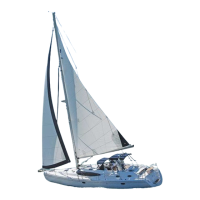nt
r
• Gettin
Underwa
1
.
harness or Bosun’s Chair intended for this use. Alwa
s
t
e
nto t
e
arness w
t
t
e
a
ar
us
n
a
ow
ne an
then secure the shackle as a back up as the knot is more
reliable than a mechanical
astner. The person hoistin
ou aloft should keep the hal
ard stopper closed to pre-
vent
alls.
ood communication between the two o
ou
is also important. Ti
hten the D2 until it has
ust become
t
t ene
t
en a
two comp
ete turns.
e at t
e
irst spreader, look up the back o
the mast to see i
it is
strai
ht
rather than bent
rom side to side
. I
it is not
strai
ht then ad
ust the appropriate D2 to strai
hten it.
7. Have the person on deck care
ull
lower
ou. The
s
ou
eep t
e
a
ar
wrappe
at
east tw
ce aroun
the winch and should alwa
s have one hand able to stop
the hal
ard
rom runnin
ree.
nce on deck, look up
the back of the mast and see if it is strai
ht
rather than
bent
rom side to side
. I
not, then ad
ust the lowers
D1
ntil it i
.
. I
ou have the standard ri
,
ou need to attach the
tr
t
t thi
tim
. Att
h th
l
w
r
n
th
tr
t t
t
e sma
er
o
e
n t
e c
a
np
ate.
ust t
e
en
t
turnin
the ball
oint bearin
in the upper end o
the strut
until the holes in the pin can be attached. It is normal to
ave some p
a
etween t
e strut an
t
e c
a
np
ate an
tr
t
r
k
t
. The final test is to
o sailin
in 10-15 knots of wind. If,
when sailin
upwind, the shrouds on the leeward side are
slack then ti
hten them to remove about hal
the slack
eepin
note of the number of turns. Then tack and do
the same to the other side. Do this until
ou are happ
with the tension and the leeward side does not
et loose
w
en t
e
oat
s
ee
e
.
ow, s
t up t
e mast to
e
sure it is still relativel
strai
ht
rom side to side. I
it is
not then ad
ust to appropriate ri
in
to correct it. For
xample: If the mast is strai
ht until the upper spreader
and then hooks to the windward side, then
ou will have
to revisit steps 6 and 7 above. Remember to alwa
s
t
ten t
e new
eewar
s
rou
, tac
an
t
ten t
e new
leeward shroud the same amount. This prevents dam-
a
e to the turnbuckles and is also much easier to do.
eep
n m
n
t
s a
so poss
e to
ave somet
n
too
ti
ht such as a dia
onal shroud.
10. At this point,
ou should have adequate headsta
ten-
sion. The sails are built
or an avera
e o
14”
350mm
headsta
sa
, possibl
more or less, dependin
upon
t or
eav
a
r.
e
en
n t
e stan
ar
mast s
ou
be about 1
maximum
o
P” and 2”
50mm
maxi-
mum
in the
urlin
mast and it should be nearl
strai
ht
from side to side when sailin
upwind. If an
of these are
not true, then revisit the appropriate step above to correct
it. If the sa
in the headsta
is too much then addin
ten-
i
n t
th
v
rti
l
will
ix it.
11.
nce the ri
is tuned,
ou should make sure to add
the cotter pins to all the ri
in
, bendin
back the ends
and tapin
them to prevent sna
ed lines, sails, and
fin
ers
emember that ri
in
, like ever
thin
else, can a
e. As
it
ets older, it ma
need to be replaced. The frequenc
or which this becomes necessar
depends on the climate
and conditions in which the boat is sailed. For example:
If
ou sail in the Caribbean, it should be replaced ever
2-
ears compared to ever
10
ears
or the
reat Lakes.
You should consult a pro
essional ri
er
or advice
13.4 Returnin
to Por
After completin
the da
’s cruise and moorin
our boat,
s
ut
own t
e en
ne.
* Reduce en
ine speed to idle. Place transmission con-
trol in neutral. Allow en
ine to idle for a few minutes.
* Move switch to
FF to shut down the en
ine
Be
ore
oin
ashore, check the
ollowin
items
hore power on and plu
ed i
Batter
char
er operatin
ha
t and rudder lo
or leaks
A thorou
h washdown of
our hull, decks, and ri
in
with soap and
resh water will help keep
our boat lookin
like new for
ears
Note: See the AC Electric section in this manual for information
on connecting the shore power, and the Water Systems chapter
for information on connecting the dockside water supply.
13.5 Emer
enc
Operations
You should alwa
s understand and be prepared to
n
a
e in Emer
enc
perations aboard
our boat. The
sea is unfor
ivin
in this area, and
ou can find
oursel
in ver
bad trouble in a ver
short time, even i
ou are
prepared.
o not rel
on this manual to educate
ou in all the

